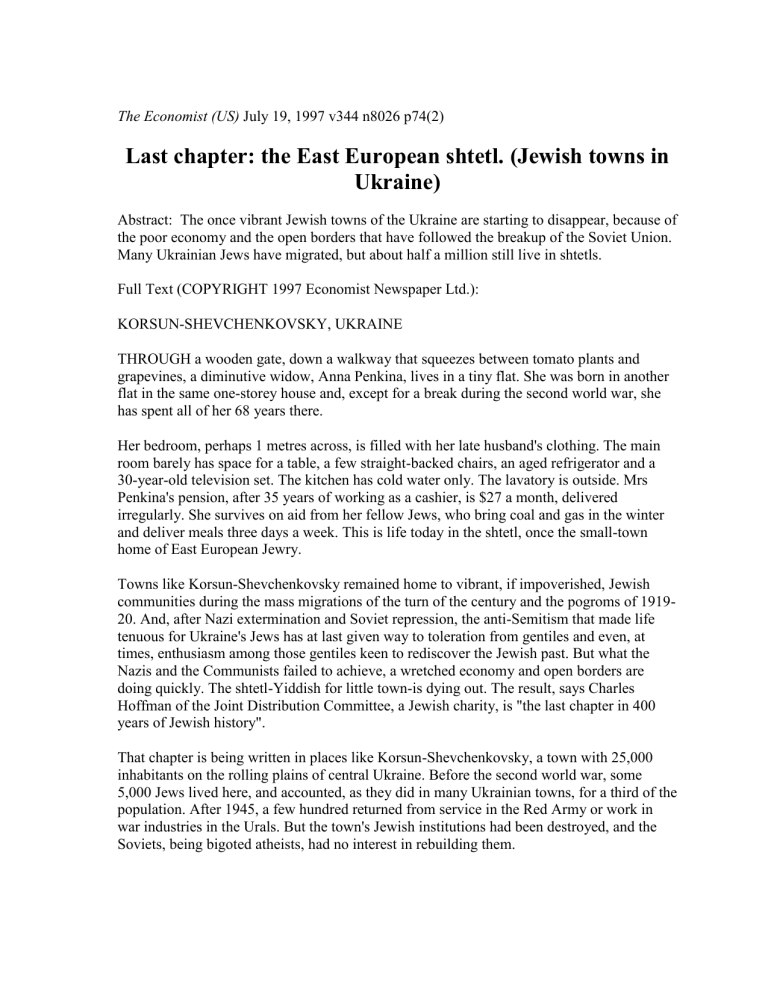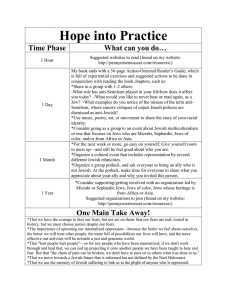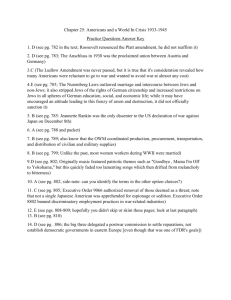Last chapter: the East European shtetl. (Jewish towns in Ukraine)

The Economist (US) July 19, 1997 v344 n8026 p74(2)
Last chapter: the East European shtetl. (Jewish towns in
Ukraine)
Abstract: The once vibrant Jewish towns of the Ukraine are starting to disappear, because of the poor economy and the open borders that have followed the breakup of the Soviet Union.
Many Ukrainian Jews have migrated, but about half a million still live in shtetls.
Full Text (COPYRIGHT 1997 Economist Newspaper Ltd.):
KORSUN-SHEVCHENKOVSKY, UKRAINE
THROUGH a wooden gate, down a walkway that squeezes between tomato plants and grapevines, a diminutive widow, Anna Penkina, lives in a tiny flat. She was born in another flat in the same one-storey house and, except for a break during the second world war, she has spent all of her 68 years there.
Her bedroom, perhaps 1 metres across, is filled with her late husband's clothing. The main room barely has space for a table, a few straight-backed chairs, an aged refrigerator and a
30-year-old television set. The kitchen has cold water only. The lavatory is outside. Mrs
Penkina's pension, after 35 years of working as a cashier, is $27 a month, delivered irregularly. She survives on aid from her fellow Jews, who bring coal and gas in the winter and deliver meals three days a week. This is life today in the shtetl, once the small-town home of East European Jewry.
Towns like Korsun-Shevchenkovsky remained home to vibrant, if impoverished, Jewish communities during the mass migrations of the turn of the century and the pogroms of 1919-
20. And, after Nazi extermination and Soviet repression, the anti-Semitism that made life tenuous for Ukraine's Jews has at last given way to toleration from gentiles and even, at times, enthusiasm among those gentiles keen to rediscover the Jewish past. But what the
Nazis and the Communists failed to achieve, a wretched economy and open borders are doing quickly. The shtetl-Yiddish for little town-is dying out. The result, says Charles
Hoffman of the Joint Distribution Committee, a Jewish charity, is "the last chapter in 400 years of Jewish history".
That chapter is being written in places like Korsun-Shevchenkovsky, a town with 25,000 inhabitants on the rolling plains of central Ukraine. Before the second world war, some
5,000 Jews lived here, and accounted, as they did in many Ukrainian towns, for a third of the population. After 1945, a few hundred returned from service in the Red Army or work in war industries in the Urals. But the town's Jewish institutions had been destroyed, and the
Soviets, being bigoted atheists, had no interest in rebuilding them.
Ukraine's breakaway from the Soviet Union, in 1991, has brought a remarkable revival. Four years ago, a group of Jews in and around Korsun-Shevchenkovsky created the Association of Small-Town Jewish Communities, which links 2,500 Jews in 19 towns of central
Ukraine. It publishes a newspaper, lends out books in places such as Shpola (home to 120
Jews) and Boguslav (home to 185), sponsors Sabbath services with lay leaders; and has a women's club and a vocal ensemble, L'Chaim, whose Russian-speaking singers bring
Yiddish songs to listeners who typically understand nothing of the language once used widely by Ukrainian Jewry.
Local authorities support this activity by providing meeting space. To attend religious school on Sundays in Korsun-Shevchenkovsky, Jewish children walk beneath a Soviet-era mosaic of an idealised youth into the Pioneer House, formerly home to a Soviet youth organisation, where a larger-than-life-sized statue of Lenin provides ironic inspiration. Most of the money, however, comes from the Joint Distribution Committee, an 83-year-old group funded by American Jews. Through local organisations such as the one in Korsun-
Shevchenkovsky, the Joint, as it is universally known, is mounting a massive private relief operation in rural Ukraine. It is the Joint which pays for the coal delivered to Mrs Penkina.
Smela, two hours' drive south of Korsun-Shevchenkovsky, used to be a shtetl. At the turn of the century it was a market town of 15,000, and half the population was Jewish. In 1959 it still had 1,800 Jews and was becoming a busy industrial centre. Today, Smela is a basket case. Many of its factories are closed, and the town is littered with the abandoned shells of unfinished buildings. Ask a local Jewish leader whether the town's 600 Jews suffer from anti-Semitism and she responds with impatience: "People have nothing to eat. This is the most important problem."
From a tiny three-room house-all of Smela's former synagogues have long since been put to other uses-volunteers have built a self-help organisation on a shoe-string. They buy meal tickets so that 42 elderly Jewish widows and widowers can eat lunch in the municipal restaurant, a glorified soup kitchen, three days a week; 15 more are on a waiting list. They try to find medicines for the ill; patients in Ukraine's overstretched hospitals must bring their own supplies. And they arrange for nurses to visit old people like Sarah, a woman trapped in her one-room flat by glaucoma and high blood pressure. Sarah's daughter, who lives in
Russia, has little money to send. The destitution is such that when The Economist's correspondent called with a plastic bag holding orange juice and biscuits, Sarah responded with thanks-and asked whether she could keep the bag too.
Millions of Ukrainians are in similar straits. Industrial wages, when they are paid at all, average only about $80 a month. On rural roads, sugar-mill workers sit next to bags of beet sugar they have received in lieu of wages, hoping to barter their product for food or cash.
But in one way Ukraine's Jews are better off than their non-Jewish neighbours: they can leave for Israel. Korsun-Shevchenkovsky has lost 120 Jewish families since 1991; of the 200 people who remain, 70% are pensioners. Among Smela's 600 Jews, only 45 are young enough to attend Sunday school. Even in the regional capital, Cherkasy, a chemicalmanufacturing centre with 4,000 Jews, the exodus is debilitating. Most of the Jews who started the local community in 1991 are now in Israel. Some of its current leaders are
preparing to follow. Its few young adults are studying Hebrew intensely in the expectation that they, too, will leave.
That will not mark the end of Ukrainian Judaism. Ukraine is still home to half a million
Jews, and in big cities with livelier economies, such as Kiev, the capital, many are staying.
But in the shtetl, the demographic tides are relentless. At best, foreign money can provide a measure of dignity for those who are left behind. It will be a modest measure. In a dim basement dining hall in Cherkasy, decorated with blue-and-white Star of David pennants, a woman who emigrated in 1988 recently watched in shock as old women dumped part of their lunch into plastic bags for dinner and breakfast. "I left Ukraine nine years ago and I never saw this," she said, "Jews having to go to the soup kitchen."
Article A19596715





